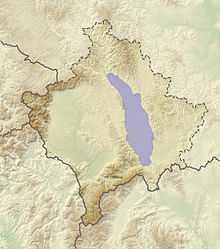Kosovo field (region)

The Kosovo field (Serbian: Kosovo polje; "field of blackbirds"; Albanian: Rrafshi i Kosovës) is a large karst field (polje), a plain located in Kosovo, in the northwest–south direction. It is mostly known for being the battlefield of the Battle of Kosovo (1389) between the Serbian and Ottoman armies, and many other battles.
It has an area of 6580 km2 and a population of 1,164,273 persons in 910 villages.[1]
Geography
The large karst field is directed northwest–south. The plain stretches from Mitrovica southwards including Obilić, Kosovo Polje (which lies in the centre), Lipljan, and almost to Kaçanik.
It is situated 500-600m above sea level.[2]
In the central part, to the west, is the Drenica valley.
History
It was the site of the Battle of Kosovo (1389) between the Serbian and Ottoman armies.[3] Serbian ruler Stefan Lazarević (1389–1427) erected a marble column with inscriptions on the field, in memory of his father.[4] Battle of Kosovo (1448) was fought between the Ottoman Empire and Kingdom of Hungary.
In 1877, the Kosovo Vilayet was established by the Ottoman Empire.
During World War I the Serbian army retreated to the Kosovo plain by November 1915, then under attack from both sides, the army withdrew across the mountains into Albania.[5]
The monument of Gazimestan was designed by Aleksandar Deroko and built in 1953 under the authority of the FPR Yugoslavia. The monument was the location of the Gazimestan speech delivered by Slobodan Milošević on the 600th anniversary of that battle in 1989, which preceded a violent surge in nationalistic and ethnic tensions prior to the Breakup of Yugoslavia.
See also
References
- ↑ Ramadani, Ibrahim, et al. "Changes in the Structure of Rural Settlements in Terms of Kosovo's Perspective and Development." Natural Environment and Culture in the Mediterranean Region II 187.194 (2011): 8.
The territory of Kosovo is mainly composed of two large regions: Dukagjini and Kosovo plain. This study covers the Kosovo plain region, which includes the eastern part of Kosovo, with an area of 6580 km2 and a population of 1,164,273 persons dispersed in 910 villages.
- ↑ Salihu, Salih, Heinrich Grausgruber, and Peter Ruckenbauer. "Agronomic and quality performance of international winter wheat genotypes grown in Kosovo." Cereal Research Communications 34.2 (2006): 957-964.
Kosovo plain (Rrafshi i Kosovés), which lies 500-600 in above sea level, and is characterised by a longtime annual precipitation of 640 mm year", and a longtime annual mean temperature of 10°C.
- ↑ John K. Cox (1 January 2002). The History of Serbia. Greenwood Publishing Group. pp. 29–. ISBN 978-0-313-31290-8.
- ↑ Michael Grünbart (30 December 2007). Material Culture and Well-Being in Byzantium (400-1453): Proceedings of the International Conference (Cambridge, 8-10 September 2001). Austrian Academy of Sciences Press. p. 197. ISBN 978-3-7001-3602-6.
- ↑ Ian V. Hogg (1995). Battles: A Concise Dictionary. Harcourt Brace. p. 87. ISBN 978-0-15-600397-1.
| ||||||